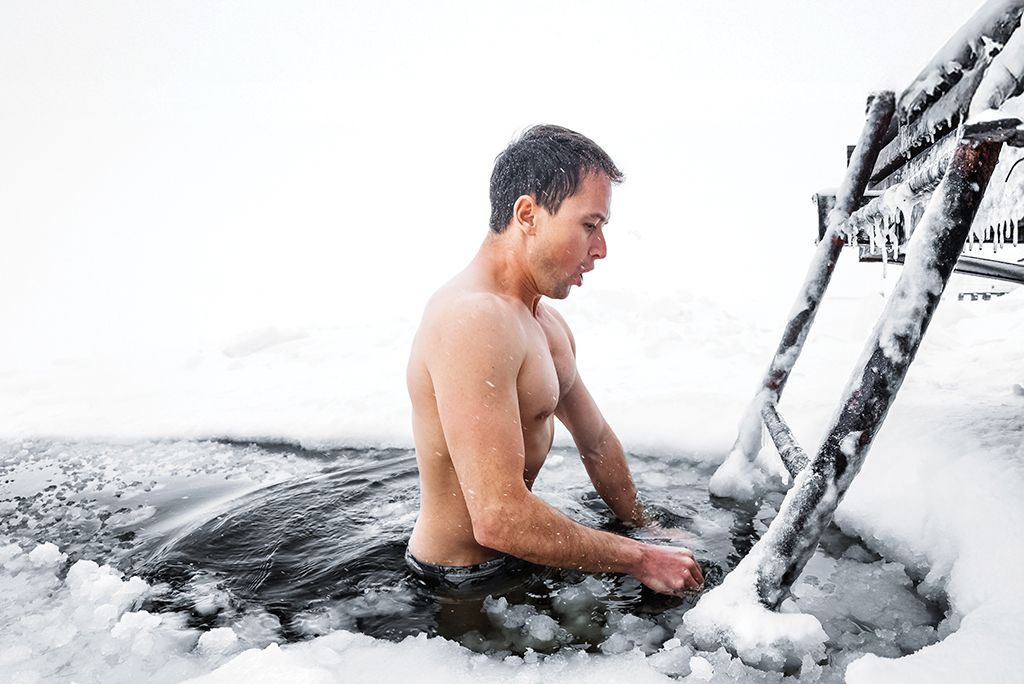Health fads come and go but one activity is as old as ice: the cold plunge. This centuries old activity stems from customs in Nordic countries and has become one of the most popular ways for people to enhance their health and well-being.
Submerging oneself in an ice bath or extremely cold tub has fantastic benefits. When combined with heat therapy, this health trend is also known as the Nordic cycle, which goes from hot to cold and repeats.
At Zenergy Health Club, the cold plunge tub is a brisk 50 degrees Fahrenheit, ready to shock early risers and wellness seekers. For Kylon Myers, the club’s Wellness Manager and a longtime health and fitness professional, cold therapy is more than a trend—it’s a powerful tool for physical and mental resilience.
“The cold plunge works through vasoconstriction,” Myers explained. “Your blood vessels tighten, reducing inflammation. When you step out, vasodilation flushes waste like lactic acid. It’s great for limiting DOMS— delayed onset muscle soreness—for up to 96 hours post-workout.”
But the benefits go beyond muscle recovery. That involuntary shiver? It’s not just your body reacting—it’s your metabolism ramping up and a flood of neurotransmitters like dopamine and epinephrine being released. “It’s a survival instinct,” he said. “That shock is your body adapting.”
The method, especially when combined with heat therapy like saunas, is gaining momentum in fitness and wellness circles. The key, Myers noted, is in the transition. “You want to air dry; let your body come back to baseline. Embrace the shivering—it triggers metabolic and cardiovascular benefits.”
Zenergy introduced its cold plunge over a year ago, and the reception has been overwhelmingly positive. “Longevity is trending,” Myers said. “Social media plays a huge role, but with that comes misinformation. You’ll see people plunging in 35-degree water for seven minutes. That’s not smart if you’re just starting out.”
Myers references Dr. Susanna Søberg, a Danish researcher known for her work on thermogenesis and cold exposure. Her protocol? Eleven total minutes of cold plunge per week, broken into sessions of one to three minutes. “Start slow,” he advised. “The temperature doesn’t need to be extreme—50 to 59 degrees is effective.”
Cold showers are a great starting point for those without access to a plunge tub. “Just make sure your head’s under, and embrace the full-body experience,” Kylon said. “Cold exposure also teaches breath control—staying calm in discomfort. That’s where mental resilience comes in.”
That mental edge is what keeps Kylon committed. “It’s the biggest gain for me— knowing I can push through something uncomfortable, find the tools to stay calm and come out stronger.”
He also stresses that contrast therapy— alternating between hot and cold—can be extremely effective, especially when structured properly. “If you want to feel energized, end with cold. If you want to relax, finish with heat. But always give your body at least two minutes to adjust between transitions.”

Taking an ice bath can reduce inflammation.
That curiosity is what drives the club to stay on the cutting edge. “We just added red light therapy. The goal is to offer a holistic health approach—to give our members tools that support recovery, performance, and longevity.”
But Myers doesn’t shy away from discussing the risks. “If you have cardiovascular issues, or if you’re pregnant, consult your doctor first. And don’t jump into extremes. Too much cold can lead to diminishing returns—the body adapts, and the benefits plateau.”
One scientifically backed benefit is the activation of brown fat, a special type of fat tissue rich in mitochondria. “Babies have a lot of it—it helps regulate temperature,” Myers said. “Cold exposure reactivates it in adults, increasing metabolism and helping the body become more efficient at using fat for energy.”
As cold therapy trends across platforms and health communities, Myers emphasizes moderation, education, and consistency. “Like exercise, it’s about introducing a stimulus and letting the body adapt over time. The goal isn’t to suffer—it’s to build strength and resilience.”
The At-Home Setup
After more than three decades in mortgage banking, Mike Preece never expected his retirement years to be filled with cedar planks, rock wool insulation and cold plunges. But when his wife began facing health issues, and the couple struggled to find a properly insulated outdoor sauna, Preece decided to build one himself.
That handcrafted, five-person sauna— designed to match the trim and siding of their Twin Falls, Idaho, home—became the foundation for MTN Sauna, a company Preece and his sons launched two years ago near the Twin Falls airport. The business focuses on custom-built, insulated outdoor saunas designed specifically for cold climates.
“Most outdoor saunas weren’t insulated, which just doesn’t cut it for Idaho winters,” Preece said. “So, I used 2×6 framing and rock wool insulation to keep the heat in.”

Taking an ice bath can seem intimidating, but the long-term effects are worth it.
What began as a personal project has become a full-service, family-run operation. MTN Sauna now works with architects and developers to design high-end wellness spaces, often integrating cold plunges, fire pits, and lighting into outdoor retreats. Inspired by figures like Wim Hof and Dr. Susanna Søberg, Preece said the combination of hot and cold therapy is gaining traction.
As for cost? “You can start with a basic setup—sauna and cold plunge—for around $4,000 to $5,000,” Preece said. “But you can easily spend $25,000 or more, depending on size and features.”
For Preece, though, the real value is personal. “It’s about creating a space where people can relax, heal and connect.”
THE BENEFITS OF TAKING A PLUNGE!
- Reduce inflammation!
- Increase Dopamine and Epinephrine!
- Ramp up metabolism — help your body become more efficient at using fat for energy


